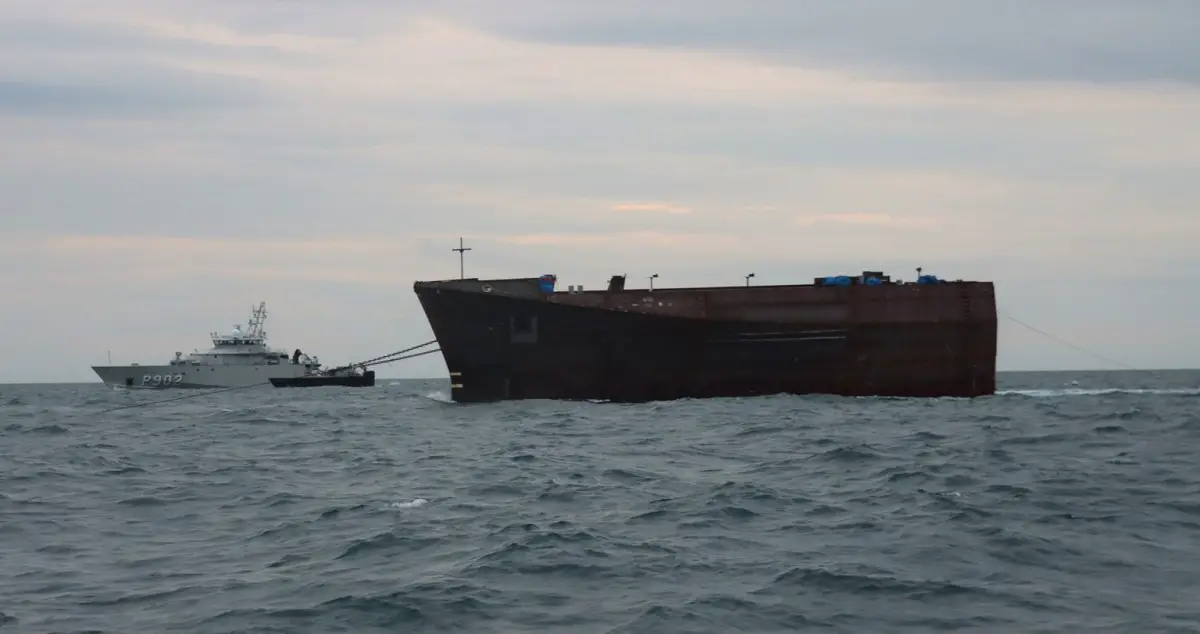The Binational Replacement Program for Mine Countermeasures Vessels (BEL-NLD), also known as the rMCM (Renovation Mine Countermeasures) program, is in full swing! The bow section (mega-block) of M941 Tournai, comprising the bow and a section of the hull (40 x 17 x 10 meters), is currently being towed by the Mentor tugboat through the Kattegat, the North Sea, the English Channel, and more, on its way to Concarneau, France, where it will be finally welded into the assembly. The bow section is expected to arrive during the first week of September. Four out of twelve Mine Countermeasures (MCM) platforms are currently under construction: M940 Ostende, Zr. Ms Vlissingen, M941 Tournai, and Zr. Ms Scheveningen.
M941 Tournai stands out in this list as it is being constructed by two shipyards. The stern and superstructure are being built in Concarneau, France, while the bow and a portion of the hull are being constructed in Gdynia, Poland. Therefore, M941 Tournai is the only ship with a distinct bow section construction entrusted to CHRIST S.A., the shipyard in Gdynia. The coastal patrol vessel Pollux had the privilege of encountering this bow section during one of its patrols in Belgian waters. It took the opportunity to capture some photos to share the ongoing modernization of our Navy. After the bow section’s arrival in France, the shipyard will assemble the superstructure, including the “toolbox” where USV drones are housed. The launch of M941 Tournai is scheduled for the late spring of 2024.
The first step in ship construction is the “first steel cut,” where the initial steel plates are cut. These plates are assembled to form blocks. A few months later, keel laying takes place, marking the first block where a coin is inserted for good luck. It’s a significant symbolic ceremony. Next comes the practical phase of “casco,” where the ship’s hull (the envelope) is built. Twenty-seven blocks (bow, deck, engine rooms, workspaces, accommodations, etc.) are assembled in different workshops. Meanwhile, heavy machinery is also mounted onboard. The ship is then launched and ready for the second practical phase: outfitting. “Outfitting” involves finalizing the ship, including electrical wiring, plumbing, insulation, cabins, painting, and more. Additional installations are also installed onboard.

After finalization, Harbor Acceptance Trials (HAT) and Sea Acceptance Trials (SAT) are conducted. In the port, the ship is powered up to check that all systems function correctly. SAT tests the ship’s navigational capabilities and is followed by a “first sea-going” ceremony, marking the ship’s maiden voyage. HAT and SAT occur separately for main installations (elecmech) and armament installations (weapons). A period of improvement implementation follows, after which the ship is delivered.
The casco phase of each ship is carried out in various shipyards, while the outfitting of all ships is done by the Concarneau shipyard.
M940 Ostende is currently in the outfitting phase in Concarneau.
Zr. Ms Vlissingen is in the casco phase in Lanester, France.
M941 Tournai is in the casco phase, with a mega-block currently being towed from Gdynia to Concarneau.
Zr. Ms Scheveningen is currently under construction (casco phase) in Georgu, Romania.
The Netherlands and Belgium are doing a joint procurement for the replacements of the Tripartite-class/Alkmaar-class minehunters. Belgium is collaborating with the Netherlands to replace their ships in the coming years under the Binational Replacement Program for Mine Countermeasures Vessels (BEL-NLD). Belgium Naval & Robotics (BNR) has secured the contract for this program and will deliver 12 mother ships. Belgium is responsible for acquiring the 12 Mine Countermeasures (MCM) vessels and the toolbox, while the Netherlands are responsible for acquiring the frigates. The new MCM ships will include a range of unmanned systems including unmanned surface, aerial and underwater vehicles alongside towed sonars and mine identification and neutralization ROVs.











